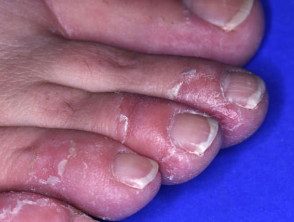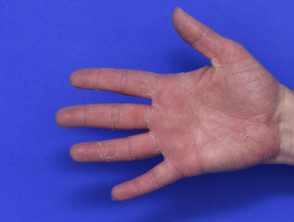What is it keratolytic winter erythema?
Winter keratolytic erythema is a rare inherited skin disorder characterized by recurrent palmoplantar erythema and peeling that often worsens in the winter months [1]. It is also known as Oudtshoorn disease and erythrokeratolysis hiemalis.
Keratolytic winter erythema was first described in 1977 by dermatologists in South Africa who observed a skin condition. predominant in families in the Oudtshoorn area of the Western Cape [2].
Keratolytic winter erythema

Keratolytic winter erythema

Keratolytic winter erythema

Keratolytic winter erythema
See more images of keratolytic winter erythema.
Who gets winter keratolytic erythema?
the predominance of winter keratolytic erythema is estimated to be 1 in 7,200 speakers of white Afrikaans [1]. It is inherited in a monogenic autosomal dominant pattern with high penetrance but variable expressiveness. It is generally diagnosed in childhood or early adulthood.
What causes winter keratolytic erythema?
Genealogical studies of affected South African families have identified a common ancestor, Captain François Renier Duminy, an 18th-century Frenchman who settled in the Cape of Good Hope [1]. Sporadic cases have also been reported.
Keratolytic winter erythema gene locus has been assigned to chromosome 8p23.1 - p22 [1]. A recent study of the human being. genome has proposed that erythema be the result of accidental duplication of an enhancing region (part of the DNA that makes your adjacent gene most likely to be "read" for transcription) along with CTSB, an important gene in keratinocytes differentiation and peeling [6].
Various environmental triggers can upset the balance of CTSB and its regulatory factors to increase cathepsin B levels, a lysosomal protease at epidermisand trigger apoptosis (body-mediated cell death) [3].
What are the clinical features of winter keratolytic erythema?
Winter keratolytic erythema generally occurs between childhood and early adulthood, and continues in an intermittent and recurring pattern [2]. Its severity varies with cyclical peeling of the skin and underlying erythema affecting the palms of the hands and the soles of the feet. [3].
- A flare begins with erythema. This could be cancel and involve the webbed spaces of the fingers and toes or the entire palm or sole of the foot. The erythema can be transgradient, spreading to the upper part of the hands and feet.
- Erythema is followed by painless superficial dry blisters or dull-appearing skin that peels off centrifugally.
- Every patch it expands 4 to 6 weeks before healing [1].
- Erythema retains the papillary ridge pattern of fingerprints.
- Palmoplantar sweating can cause a pungent odor and increased desquamation.
Some patients with winter keratolytic erythema also develop ring erythema on the extremities, buttocks, or trunk; There has been one reported case of facial involvement [4].
Aggravating factors may include:
- Winter season
- Excessive exposure to water, chemicals, or friction. [two]
- Disease
- Psychological stress
- Menstruation
- Secondary bacterial infection
- Certain medications that include current steroids and general anesthesia.
Keratolytic winter erythema can improve in summer and during pregnancy. [3].
What are the complications of winter keratolytic erythema?
Active outbreaks of winter keratolytic erythema can be disabling in severe cases.
How is winter keratolytic erythema diagnosed?
The diagnosis of keratolytic winter erythema may be clinically evident and may be supported by a positive family history.
On the skin biopsy, keratolytic winter erythema shows characteristics histopathology with basal keratinocytes proliferation and faulty layers of the stratum corneum [5].
Which is the differential diagnosis for winter keratolytic erythema?
Depending on the phase of the injury, the differential diagnosis of winter keratolytic erythema may include [6]:
- Exfoliative keratolysis
- Palmoplantar keratoderma
- Located simple epidermolysis bullosa
- Circumscribed palm hypokeratosis
- Annular erythema
-
Erythrokeratoderma.
What is the treatment for winter keratolytic erythema?
There is currently no established effective treatment for winter keratolytic erythema. Topical keratolytics, retinoids and steroids can aggravate winter keratolytic erythema [6]. Photodynamic therapy has shown disease-modifying results in one patient [5].
What is the result of winter keratolytic erythema?
Winter keratolytic erythema generally improves or even disappears during the summer months [4]. It also tends to improve with age and there may be only a minimal climbing in the folds in adulthood [1]. In some severely affected individuals, it will persist. [two].

